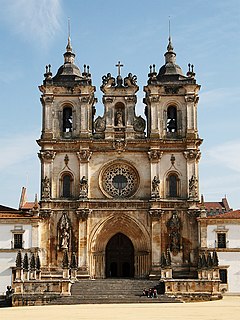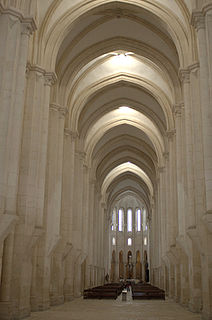
The Cathedral of Saint Mary Major, often called Lisbon Cathedral or simply the Sé, is a Roman Catholic cathedral located in Lisbon, Portugal. The oldest church in the city is the seat of the Patriarchate of Lisbon. Built in 1147, the cathedral has survived many earthquakes and has been modified, renovated and restored several times. It is nowadays a mix of different architectural styles. It has been classified as a National Monument since 1910.

Coimbra is a city and a municipality in Portugal. The population of the municipality at the 2011 census was 143,397, in an area of 319.40 square kilometres (123.3 sq mi). The fourth-largest urban centre in Portugal, it is the largest city of the district of Coimbra and the Centro Region. About 460,000 people live in the Região de Coimbra, comprising 19 municipalities and extending into an area of 4,336 square kilometres (1,674 sq mi).

Vila do Conde is a municipality in the Norte Region of Portugal. The population in 2011 was 79,533, in an area of 149.03 km². The urbanized area of Vila do Conde, which includes the parishes of Vila do Conde, Azurara and Árvore, represent 36,137 inhabitants. Vila do Conde is interlinked to the north with Póvoa de Varzim, forming a single urban agglomeration which is a part of the Porto Metropolitan Area. The town is on the Portuguese Way of the Camino de Santiago.

Elizabeth of Aragon, more commonly known as Saint Elizabeth of Portugal, T.O.S.F., was queen consort of Portugal, a tertiary of the Franciscan Order and is venerated as a saint of the Catholic Church.

The Monastery of Batalha is a Dominican convent in the municipality of Batalha, in the district of Leiria, in the Centro Region of Portugal. Originally, and officially, known as the Monastery of Saint Mary of the Victory, it was erected in commemoration of the 1385 Battle of Aljubarrota and would serve as the burial church of the 15th-century Aviz dynasty of Portuguese royalty. It is one of the best and original examples of Late Flamboyant Gothic architecture in Portugal, intermingled with the Manueline style.

The Old Cathedral of Coimbra is a Romanesque Roman Catholic building in Portugal. Construction of the Sé Velha began some time after the Battle of Ourique (1139), when Prince Afonso Henriques declared himself King of Portugal and chose Coimbra as capital. The first Count of Coimbra, the Mozarab Sisnando Davides, is buried in the cathedral.

The Alcobaça Monastery is a Catholic monastic complex located in the town of Alcobaça, in central Portugal, some 120 km north of Lisbon. The monastery was established in 1153 by the first Portuguese king, Afonso Henriques, and would develop a close association with the Portuguese monarchy throughout its seven-century-long history.

The Monastery of Jesus is a historical religious building in Setúbal, Portugal, which served a monastery of Poor Clare nuns. It is one of the first buildings in the Manueline style, the Portuguese version of late Gothic. The cloisters of the complex houses a museum of the monastery.

Monastery of Santa Clara or Convent of Santa Clara in Vila do Conde, Portugal was one of the biggest and richest feminine convents in Portugal, founded in 1318, by Afonso Sanches and his wife, Teresa Martins Telo.

Santa Chiara is a religious complex in Naples, Italy, that includes the Church of Santa Chiara, a monastery, tombs and an archeological museum. The Basilica church of Santa Chiara faces Via Benedetto Croce, which is the easternmost leg of Via Spaccanapoli. The church facade of Santa Chiara is diagonally across from the church of Gesù Nuovo.

Diogo de Boitaca was an influential architect and engineer of some of the most important Portuguese buildings, working in Portugal in the first half of the 16th century.

Portuguese architecture refers to both the architecture of present-day Portugal's territory in Continental Portugal, the Azores and Madeira, as well as the architectural heritage/patrimony of Portuguese architects and styles throughout the world, particularly in countries formerly part of the Portuguese Empire.

Spanish Gothic architecture is the style of architecture prevalent in Spain in the Late Medieval period.

Portuguese Gothic architecture is the architectural style prevalent in Portugal in the Late Middle Ages. As in other parts of Europe, Gothic style slowly replaced Romanesque architecture in the period between the late 12th and the 13th century. Between the late 15th and early 16th century, Gothic was replaced by Renaissance architecture through an intermediate style called Manueline.

The Monastery of Santa Clara-a-Nova is a monastery in Coimbra, Portugal. It was built to replace the mediaeval Monastery of Santa Clara-a-Velha, located nearby, which at the time was prone to frequent flooding by the waters of the Mondego river. The monastery was built in the 17th and 18th centuries and is classified as a National Monument. It is located in the Santa Clara parish.

Santa Clara is a former civil parish in the municipality of Coimbra, Portugal. In 2013, the parish merged into the new parish Santa Clara e Castelo Viegas. It has a population of 9637 (2001) and an area of 9.77 km². It is an urban parish, in the city Coimbra, and on the south of the Mondego river.

Sangalhos is a town and a civil parish in the municipality of Anadia, Portugal. The population in 2011 was 4,068, in an area of 16.90 km².

The Romanesque style of architecture was introduced in Portugal between the end of the 11th and the beginning of the 12th century. In general, Portuguese cathedrals have a heavy, fortress-like appearance, with crenellations and few decorative elements apart from portals and windows. Portuguese Romanesque cathedrals were later extensively modified, among others the Old Cathedral of Coimbra, although it only had some minor changes.

The Convent of St. Clare is a former convent of the Order of Poor Clares, located in the city centre of Pontevedra, Spain, precisely in Santa Clara Street, near the old St. Clare Gate of the old city walls.






















